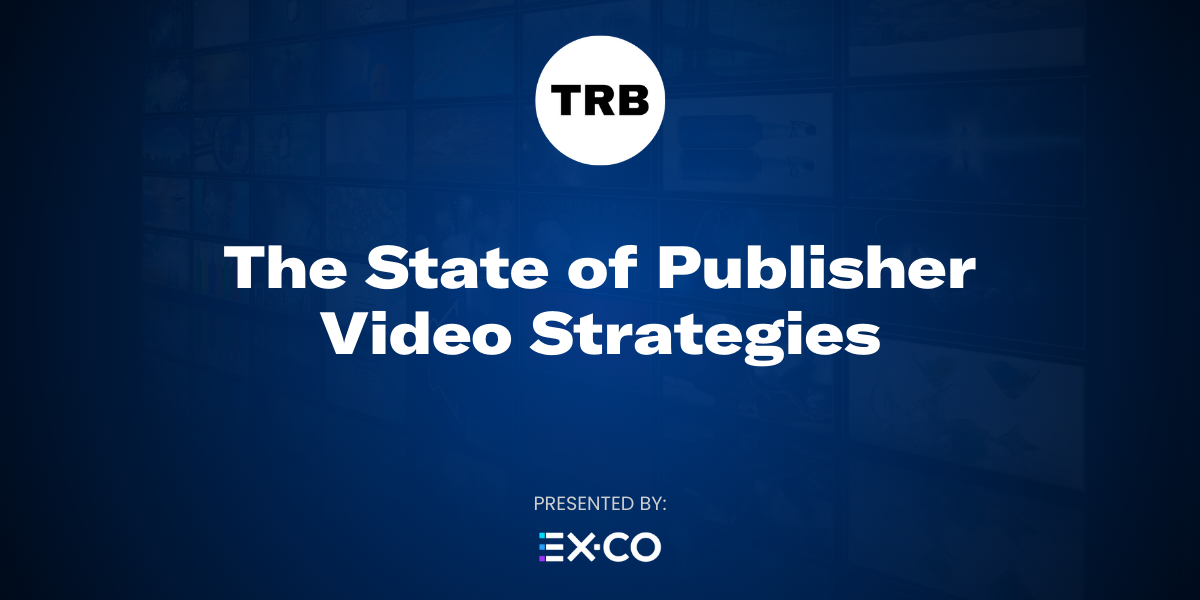The state of publisher video strategies
Balancing UX and monetization

The State of Publisher Video Strategies report aims to provide a comprehensive overview of how publishers are thinking about video today, on both the revenue and the product sides. By examining a range of relevant concerns—from monetization to contextuality to reader engagement—this report seeks to offer insights that can guide strategic decisions in the news industry.
To compile this report, The Rebooting surveyed 49 media companies. 46% of respondents came from the revenue side of publishers, 38% from product, and 15% from other parts of the organization. We supplemented this with stakeholder interviews.
Our findings show an industry in transition. Media companies have shaken off the hangover from the "pivot to video" mid-2010s and are ready to re-embrace video as both a revenue driver and an editorial asset. At the same time, they're still in the early stages of figuring out how to strike a balance between the monetization opportunities apparent with video and the complexities.
This survey and report aim to shed light on the challenges (and opportunities) surrounding publisher video and to explore how publishers can make the most of this emerging revenue stream.
The pivot-to-video hangover has passed
The words "pivot to video" alone are enough to make an entire generation of media employees shudder, and with good reason: the last widespread industry attempt to integrate video content was a more or less unmitigated disaster. Editorial teams were prematurely slashed and money was poured into half-baked video operations, in anticipation of an immense video-hungry audience that never materialized. The numbers, famously, were comically inflated—and publishers were as guilty here as the big social platforms.
Video cuts across the publishing organization when it comes to decision making, highlighting the important tradeoffs that inevitably are made in publishing.
80% of respondents said their site is using video in some capacity. Notably, these videos are dispersed throughout publisher websites, appearing on an average of 65% of pages. Publishers report relying on their sites for most of their video views.
This suggests that the scars of the "pivot to video" moment have healed: publishers are once again enthusiastic about the potential of online video and are actively working to integrate it throughout their operations.
At the same time, it is clear that publishers are still in the early days of this process. Despite the ubiquity of video content across publisher sites, only 23% rated their site's video experience as at least "good"—and 0% rated it as "excellent."
“With video being one of the more engaging forms of content, there is a strong opportunity to secure premium ad placements and sponsorship deals,” said a CPO at a significant niche media network. “At the same time, balancing ad loads with content relevance is crucial, as an aggressive ad approach could lead to audience dissatisfaction.”
When push comes to shove at publishers, monetization beats out user experience.
What is clear is that amassing even a small library of high-quality video is an immense (not to mention expensive) undertaking. On the other hand, audiences have shown a heartening interest in comparatively low-effort content like livestreams and video podcasts. Added to this mix is the option of syndicating third-party content—keeping users on-site at the slight risk of brand dilution—and generating quick content via AI. Navigating these paths forward without losing sight of revenue goals will be a central task for publishers moving forward.
Video is a revenue proposition
In a sense, video heightens many of the eternal tensions between revenue and product teams. Video is a prime revenue generator but product teams are understandably wary of overloading pages with cumbersome or slow-loading players. This is a productive tension, and publishers are working it out in real time. At its heart is a question: who—or what—is video for?
Per our survey, most publishers are right now thinking of video as a revenue proposition. Fifty nine percent of respondents said their main priority in adopting video is monetization, in contrast to just 14% who cited "satisfying audience demand." Those two things aren’t mutually exclusive, but these results do suggest that publishers aren’t thinking about video as a core editorial product; rather, they see video as a way to shore up leaking revenue streams and ensure a continued ability to churn out high-quality text-based editorial.
And in fact, a slight hit to UX in the service of greater revenue goals would appear to be something most publishers are comfortable with: in a scenario where a publisher would have to choose between the two, 73% said they’d go for more revenue (with only 27% saying they’d opt for better UX). It would be a mistake to view this as opportunistic, for the simple reason that, without increased revenue, many of these sites would struggle to survive in the first place—rendering the niceties of “user experience” irrelevant.
Again, the fundamental tension here is familiar: editorial teams want exclusively high-quality video, revenue teams want as much video as possible. A compromise will need to be reached, as video can only start earning for publishers when it exists in significant quantity. These questions are being worked out and the landscape here will likely look very different even six months from now.
And yet few publishers report using first-party audience data in order to personalize their video experience, in contrast to other goals.
One thing working in publishers’ favor here: audiences happen to have a fairly high tolerance for difficult-to-navigate site experiences at this point. One product exec at a major news organization, whose website deploys both autoplay and sticky players, concedes these tactics “don’t thrill me” but says, “We’ve paid close attention to the negative engagement signals, and we’ve seen nothing that would make us pull back.” In other words: you can push a user fairly far before they give up. How far one should push is a different story, one that publishers are still in the process of working out.
At a time when traffic is top of mind, publishers for the most part are not concerned about video on their pages hurting their SEO.
Of course, this second wave of publisher video comes at a time when publishers are experimenting with all kinds of new revenue streams, from tiered subscriptions to events, merch, games, and beyond. In that sense, video is—at least this time around—additive: another way to drive revenue, as opposed to something to reorient an entire editorial operation around (as happened in the mid-2010s).
Contextuality is key
One legacy of the "pivot to video" era is a heightened wariness among publishers around spammy or irrelevant-seeming video content. Back in the Wild West 2010s, videos would surface without rhyme or reason: articles about deadly hurricanes coupled with videos about pop star breakups, etc. This alienated readers and diluted publisher brands. Unsurprisingly, in this new wave of video, contextuality is paramount: 32% of respondents cited it as "important" and 45% as "very important."
Of course, contextual does not always mean directly, literally relevant. It is great when a publisher can (for instance) augment an article about a TV show with a video podcast episode centered on that show, but instances like these are comparatively infrequent and also not particularly scalable. In fact, by far the most commonly cited video-related challenge for publishers is a lack of video content (41%).
To that end, publishers are showing a willingness to be somewhat less than relevant in the service of, for instance, pushing fresher content: “The trade-off is between the immediacy of video content and ensuring its relevance,” as the niche-media CPO put it. “On occasion, prioritizing timeliness may mean placing slightly tangential content, but we try to limit this to ensure user satisfaction remains high while not losing revenue.” Additionally, when it comes to bulking out content libraries, “partnering with broadcasters, licensing deals, and investing in original content production have helped mitigate these issues.”
In the near-term, publishers will continue to build out their video operations and get more creative with the kinds of low-effort, audience-friendly content native to platforms like TikTok, Instagram, etc. But even a sizable video production team will never be able to make a video for every article published on a given site.
What this points to, then, is a live question for publishers, one that ties into our earlier discussion of user experience: i.e., how relevant does a video need to be before you feel comfortable showing it to a user? There is absolutely a balance to be found here and working it out is a key collaborative task for revenue, product, and editorial teams at the moment.
Audiences want vertical video
One significant reason that the real pivot to video is happening now, as opposed to ten years ago, is that the rest of the internet has pivoted to video in the interim. To a large degree, audiences—and particularly young audiences—are spending most of their online leisure time engaging with short-form video content. TikTok inaugurated this era but the major platforms have followed suit, with both X.com and Instagram today functioning first and foremost as short-form video delivery platforms.
On these platforms, of course, vertical video—i.e. mobile-optimized video—predominates. Despite this, per our survey, publishers have been slower to get onboard with it. Only 27% of respondents say that their site deploys vertical video, and of these just a little more than half (53%) produce those vertical videos themselves. Those that don’t deploy vertical video cited a variety of factors, with production budgets/resources heading the list (38%) followed by such disparate factors as the lack of ad demand and difficulty of tech implementation.
The difficulty, of course, is in actually monetizing this vertical content: 50% of publishers who use vertical video said it monetizes at a lower rate than wide format, and 0% said it monetizes at a higher rate.
“It still really doesn’t monetize at all, outside of native platforms” said a product executive at a major news organization. “There’s not much of a programmatic vertical video ad exchange. Obviously, the TikToks of the world are driving an awful lot of revenue through it, so you think it would spill over—but I don’t know that it really has yet.”
According to this product executive, a trial vertical video initiative was quickly shut down for lack of revenue; they (and the industry at large) are still at work sorting out some way to earn off of this kind of content.
The way forward
Publishers can’t be blamed for going all-in on video a decade ago. Facebook, among others, sweetened the pot such that not turning to video felt like leaving money on the table. This was especially appealing at a time when digital media appeared to be in serious crisis.
Digital media no longer appears to be in serious crisis: it is, definitively, in serious crisis. Into this environment, video has re-emerged as a quiet savior: a way to (when deployed correctly) hit revenue targets without diluting brand credibility.
As crucially, advertisers—increasingly fickle on what kinds of news content they’ll be featured next to—are all-in on the medium as well, willing to pay premiums far higher than those that publishers have grown glumly accustomed to in recent years.
The question for publishers in this new environment is how best to integrate video in a way that makes sense for their brand. The fact is that video is expensive to produce, which means that a kind of syndication is likely inevitable, even desirable, at least in the early stages before platforms have built up sufficiently large content libraries of their own. The niche-media CPO pointed to “user-generated content and contributions from influencers” as one potential source of material, in addition to third-party licensing and AI-generated content based on articles.
Retention is the ultimate objective here—upping engagement and keeping people on-site for longer, reconceptualizing the website as the standalone consumer destination. Video, after a rocky start a decade ago, has finally established itself as a viable pathway towards that goal.




